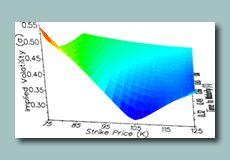
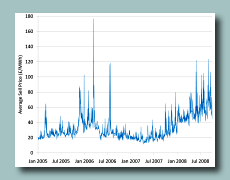
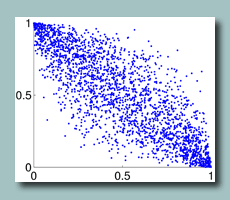
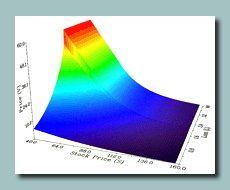

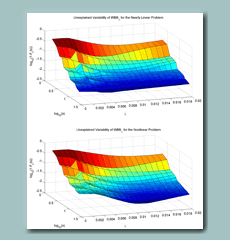
|
|
Papers
|
| |
- Efficient Construction of Robust Hedging Strategies under Jump Models (with Matt Davison) (March 3, 2010) [SSRN] [BIB]
Markets where asset prices follow processes with jumps are incomplete and any portfolio hedging against large movements in the price of the underlying asset must include other instruments. The standard approach in literature is to minimize the price variance of the hedging portfolio under a certain choice for the jump size distribution. This paper generalizes the hedging strategy of Kennedy, Forsyth, and Vetzal (2009) to minimize the weighted variance of hedging portfolio price and Greeks (sensitivities of portfolio values to changes in the state variables or models parameters). The new approach yields improved hedging portfolios over long horizons (i.e. semi-static and static hedging) and for non-stationary model parameters (e.g. stochastic volatility or jump arrival rate). From the computational perspective, this paper develops a new Fourier transform-based numerical method for computing the Greeks of European options with arbitrary payoffs by extending the work of Jackson, Jaimungal, and Surkov (2008). The new computational method allows to rapidly compute the hedging portfolio weights of the generalized hedging approach. We demonstrate the precision and efficiency of the new numerical scheme and perform a comparative analysis of various hedging approaches.
- Valuing Early Exercise Interest Rate Options with Multi-Factor Affine Models (with Sebastian Jaimungal) (March 3, 2010) [SSRN] [BIB]
Multi-factor interest rate models are widely used in practice. Quite often, contingent claims with earlier exercise features are valued by resorting to trees, finite-difference schemes and Monte Carlo simulations. However, when jumps are present these methods are less accurate and/or efficient. In this work we develop an algorithm based on a sequence of measure changes coupled with Fourier transform solutions of the pricing partial-integro differential equation to solve the pricing problem. The method, coined the irFST method, also neatly computes option sensitivities. Furthermore, we develop closed form formulae for accrual swaps and accrual range notes under our multi-factor jump-diffusion model. We demonstrate the versatility and precision of the method through numerical experiments on European, Bermudan and callable bond options, (accrual) swaps and range notes.
- Option Pricing using Fourier Space Time-stepping Framework (Ph.D. Thesis) (August 18, 2009) [SSRN] [BIB]
This thesis develops a generic framework based on the Fourier transform for pricing and hedging of various options in equity, commodity, currency, and insurance markets. The pricing problem can be reduced to solving a partial integro-differential equation (PIDE). The Fourier Space Time-stepping (FST) framework developed in this thesis circumvents the problems associated with the existing finite difference methods by utilizing the Fourier transform to solve the PIDE. The FST framework-based methods are generic, highly efficient and rapidly convergent. The Fourier transform can be applied to the pricing PIDE to obtain a linear system of ordinary differential equations that can be solved explicitly. Solving the PIDE in Fourier space allows for the integral term to be handled efficiently and avoids the asymmetrical treatment of diffusion and integral terms, common in the finite difference schemes found in the literature. For path-independent options, prices can be obtained for a range of stock prices in one iteration of the algorithm. For exotic, path-dependent options, a time-stepping methodology is developed to handle barriers, free boundaries, and exercise policies.
- Levy Based Cross-Commodity Models and Derivative Valuation (with Sebastian Jaimungal) (November 17, 2008) [SSRN] [BIB]
Energy commodities, such as oil, gas and electricity, lack the liquidity of equity markets, have large costs associated with storage, exhibit high volatilities and can have significant spikes in prices. Furthermore, and possibly most importantly, commodities tend to revert to long run equilibrium prices. Many complex commodity contingent claims exist in the markets, such as swing and interruptible options; however, the current method of valuation relies heavily on Monte Carlo simulations and tree based methods. In this article, we develop a new cross-commodity modeling framework which accounts for jumps and cointegration in prices and introduce a new valuation methodology for derivatives by working in Fourier space. The method is based on the Fourier space time stepping algorithm of Jackson, Jaimungal, and Surkov (2008), but is tailored for mean-reverting models. We demonstrate the utility of the method by applying it to the valuation of European, American and barrier options on a single underlier, and European and Bermudan spread options on two commodities.
- Stepping Through Fourier Space (with Sebastian Jaimungal) (October 9, 2008) [SSRN] [BIB]
Diverse finite-difference schemes for solving pricing problems with Levy underliers have been used in the literature. Invariably, the integral and diffusive terms are treated asymmetrically, large jumps are truncated, the methods are difficult to extend to higher dimensions and cannot easily incorporate regime switching or stochastic volatility. We present a new efficient approach which switches between Fourier and real space as time propagates backwards. We dub this method Fourier Space Time-Stepping (FST). The FST method applies to regime switching Levy models and is applicable to a wide class of path-dependent options (such as Bermudan, barrier, shout and catastrophe linked options) and options on multiple assets.
- Parallel Option Pricing with Fourier Space Time-stepping Method on Graphics Processing Units (October 8, 2007) [SSRN] [BIB]
With the evolution of Graphics Processing Units (GPUs) into powerful and cost-efficient computing architectures, their range of application has expanded tremendously, especially in the area of computational finance. Current research in the area, however, is limited in terms of options priced and complexity of stock price models. This paper presents algorithms, based on the Fourier Space Time-stepping (FST) method, for pricing single and multi-asset European and American options with Levy underliers on a GPU. Furthermore, the single-asset pricing algorithm is parallelized to attain greater efficiency.
- Option Pricing with Regime Switching Levy Processes Using Fourier Space Time-stepping (with Ken Jackson and Sebastian Jaimungal) (April 30, 2007) [PDF] [BIB]
Although jump-diffusion and Levy models have been widely used in industry, the pricing partial-integro differential equations poses various difficulties for valuation. Diverse finite-difference schemes for solving the problem have been introduced in the literature. Invariably, the integral and diffusive terms are treated asymmetrically, large jumps are truncated and the methods are difficult to extend to higher dimensions. We present a new efficient transform approach for regime-switching Levy models which is applicable to a wide class of path-dependent options (such as Bermudan, barrier, and shout options) and options on multiple assets.
- Fourier Space Time-stepping for Option Pricing with Levy Models (with Ken Jackson and Sebastian Jaimungal) (March 14, 2007) [SSRN] [BIB]
It is well known that the Black-Scholes-Merton model suffers from several deficiencies. Jump-diffusion and Levy models have been widely used to partially alleviate some of the biases inherent in this classical model. Unfortunately, the resulting pricing problem requires solving a more difficult partial-integro differential equation (PIDE) and although several approaches for solving the PIDE have been suggested in the literature, none are entirely satisfactory. All treat the integral and diffusive terms asymmetrically and are difficult to extend to higher dimensions. We present a new, efficient algorithm, based on transform methods, which symmetrically treats the diffusive and integrals terms, is applicable to a wide class of path-dependent options (such as Bermudan, barrier, and shout options) and options on multiple assets, and naturally extends to regime-switching Levy models. We present a concise study of the precision and convergence properties of our algorithm for several classes of options and Levy models and demonstrate that the algorithm is second-order in space and first-order in time for path-dependent options.
- Valuation of Mortgage-Backed Securities in a Distributed Environment (February 18, 2004) [PDF]
Valuation of Mortgage-Backed Securities, regarded as integration in high-dimensional space, can be readily performed using the Monte Carlo method. The Quasi-Monte Carlo method, by utilizing low-discrepancy sequences, has been able to achieve better convergence rates at computational finance problems despite analysis suggesting that the improved convergence comes into effect only at sample sizes growing exponentially with dimension. This may be attributed to the fact that the integrands are of low effective dimension and quasi-random sequences' good equidistribution properties in low dimensions allow for the faster convergence rates to be attained at feasible sample sizes. The Brownian bridge discretization is traditionally used to reduce the effective dimension although an alternate choice of discretization can produce superior results. This paper examines the standard Brownian bridge representation and offers a reparametrization to further reduce dimension. The performance is compared both in terms of improvement in convergence and reduced effective dimensionality as computed using ANOVA decomposition. Also, porting of the valuation algorithm to a distributed environment using Microsoft .NET is presented.
|
|
|











